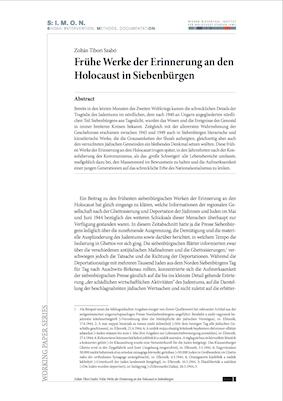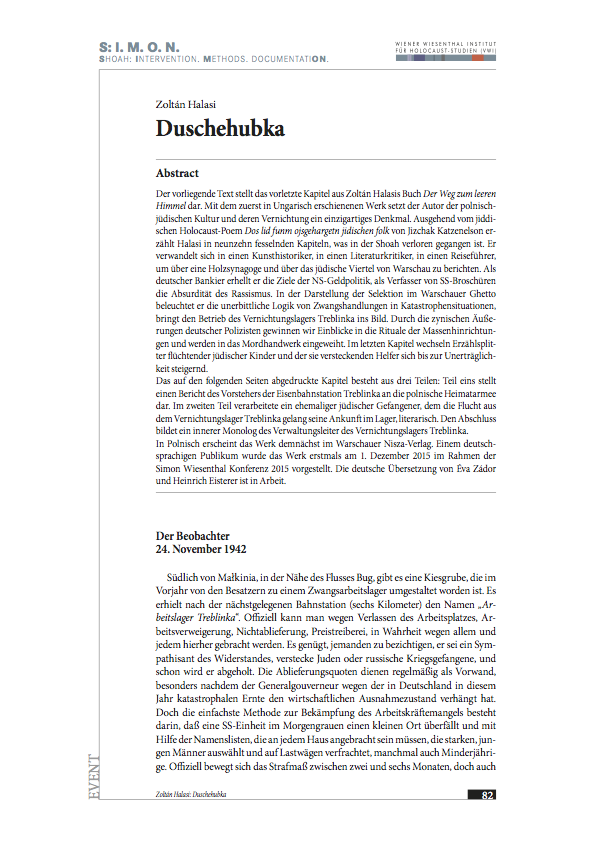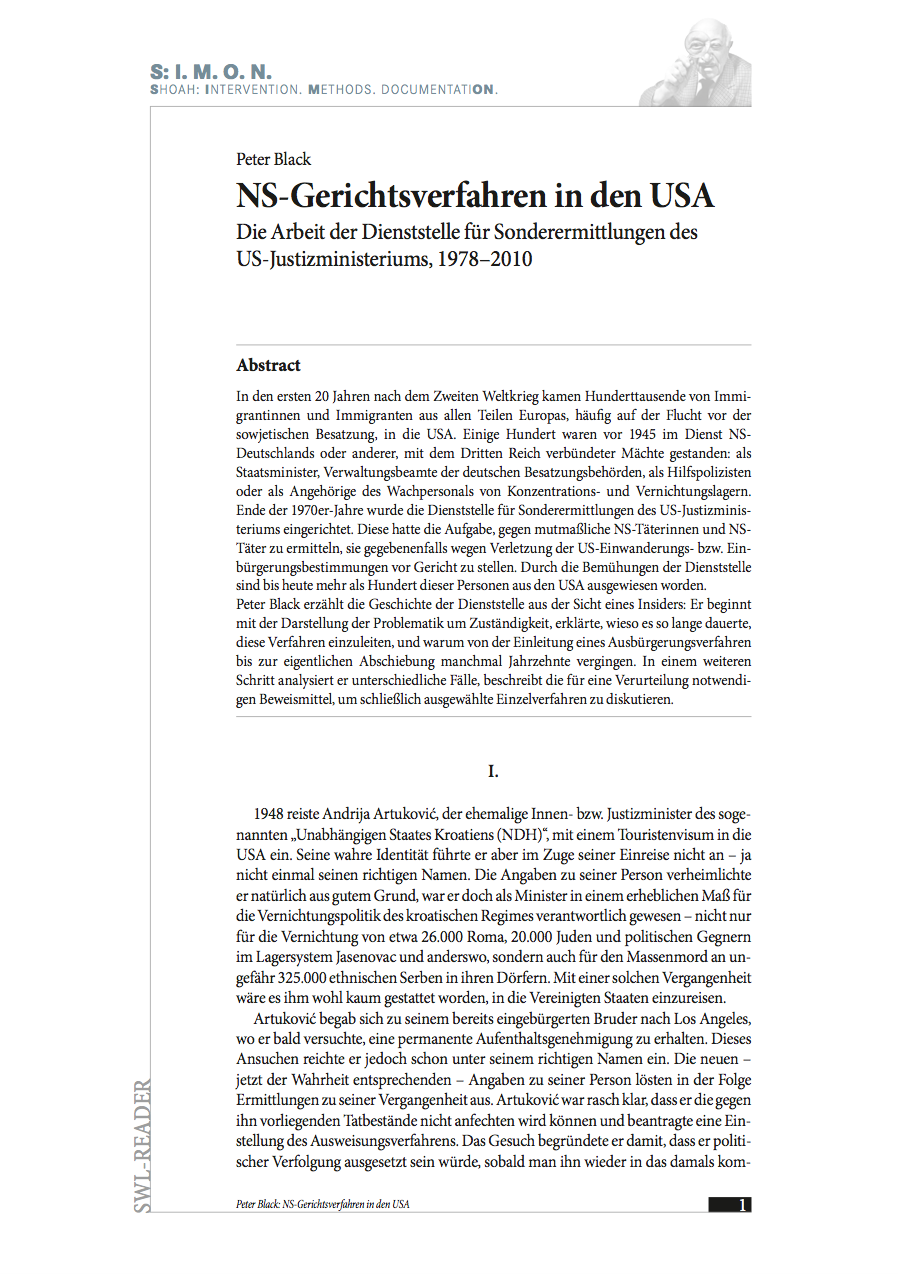 This paper introduces the everyday realities of ‘race defilement’ practices in early 1940s Hungary through a case study. I argue that race defilement was an integral part of the Hungarian őrségváltás, ‘the changing of the guards’, in which the so-called ‘Christian’ middle class tried to push their ‘Jewish’1 male rivals away from economic and political opportunities and this included access to ‘honourable, Christian women’. The case of a well-to-do and influential lawyer exemplifies that the judicial system was especially keen on enforcing őrségváltás by handing out punitive measures for Jews who were in a position of power and therefore seemed more of a threat to the non-Jewish elite. The case study also shows that playing with the gendered notion of ‘honour’ and with the resources still available to Jews in Horthy-era Hungary in the early 1940s, the outcome of cases could be swung. I here employ an emotional history approach and Michel Foucault’s concept of the psychological-ethical ‘double’ to indicate how emotions and readily available stereotypes were used by the actors of this particular case for various, often game-changing purposes.
This paper introduces the everyday realities of ‘race defilement’ practices in early 1940s Hungary through a case study. I argue that race defilement was an integral part of the Hungarian őrségváltás, ‘the changing of the guards’, in which the so-called ‘Christian’ middle class tried to push their ‘Jewish’1 male rivals away from economic and political opportunities and this included access to ‘honourable, Christian women’. The case of a well-to-do and influential lawyer exemplifies that the judicial system was especially keen on enforcing őrségváltás by handing out punitive measures for Jews who were in a position of power and therefore seemed more of a threat to the non-Jewish elite. The case study also shows that playing with the gendered notion of ‘honour’ and with the resources still available to Jews in Horthy-era Hungary in the early 1940s, the outcome of cases could be swung. I here employ an emotional history approach and Michel Foucault’s concept of the psychological-ethical ‘double’ to indicate how emotions and readily available stereotypes were used by the actors of this particular case for various, often game-changing purposes.
Editorial
 S:I.M.O.N. is an e-journal of the Vienna Wiesenthal Institute for Holocaust Studies (VWI). It appears twice a year in English and German language. S:I.M.O.N. aims at both a transnational and comparative history of the Holocaust and Jewish Studies in Central and Eastern Europe within the broader contexts of the European history of the 20th and 21st century, including its prehistory, consequences and legacies as well as the history of memory.
S:I.M.O.N. is an e-journal of the Vienna Wiesenthal Institute for Holocaust Studies (VWI). It appears twice a year in English and German language. S:I.M.O.N. aims at both a transnational and comparative history of the Holocaust and Jewish Studies in Central and Eastern Europe within the broader contexts of the European history of the 20th and 21st century, including its prehistory, consequences and legacies as well as the history of memory.
S:I.M.O.N. serves as a forum for discussion of various methodological approaches. The journal especially wishes to strengthen the exchange between researchers from different scientific communities and to integrate both the Jewish history and the history of the Holocaust into the different “national” narratives. It also lays a special emphasis on memory studies and the analysis of politics of memory. S:I.M.O.N. uses a double-blind review system, which means that both the reviewer’s and the author’s identities are concealed from each other hroughout the review process.
Shoah: The journal deals with the history of the Shoah from multidisciplinary, transnational and comparative perspectives. It seeks to integrate studies on Jews as well as on other groups of victims of the Holocaust, especially on Roma, and of so far less researched regions of (East) Central and (South) Eastern Europe.
Intervention. The journal reports on research projects and their transmission into public events. It also informs about current educational and remembrance programs.
Methods. The journal serves as a forum for the discussion of methodological approaches as, for instance, the everyday history, oral history, gender history, the history of violence, anti-Semitism and racism and the theory of memory and memory politics.
DocumentatiON. The journal contributes to critical approaches on using and interpreting archival materials in the 21st century.
Download the current issue S:I.M.O.N. 2017/2.
Articles
Zoltán Tibori Szabó
Frühe Werke der Erinnerung an den Holocaust in Siebenbürgen
 The terrible details of the tragedy of Jewry in the northern part of Transylvania, which had been annexed to Hungary after 1940, emerged even in the last months of the Second World War, when the essence and events of the genocide were known in ever wider circles. As awareness of the events first emerged, literary and artistic works were also published in Transylvania between 1945 and 1949 that depicted the cruelties of the Shoah and at the same time aimed to raise a lasting monument for the Jewish communities that had been destroyed. These early works of Holocaust remembrance made a considerable contribution to retaining the mass murder in people's consciousness and turning a young generation's awareness to the terrible heritage of Nazism later on, when, during the decades of consolidation of communism, all spheres of life were submerged in a “great silence”.
The terrible details of the tragedy of Jewry in the northern part of Transylvania, which had been annexed to Hungary after 1940, emerged even in the last months of the Second World War, when the essence and events of the genocide were known in ever wider circles. As awareness of the events first emerged, literary and artistic works were also published in Transylvania between 1945 and 1949 that depicted the cruelties of the Shoah and at the same time aimed to raise a lasting monument for the Jewish communities that had been destroyed. These early works of Holocaust remembrance made a considerable contribution to retaining the mass murder in people's consciousness and turning a young generation's awareness to the terrible heritage of Nazism later on, when, during the decades of consolidation of communism, all spheres of life were submerged in a “great silence”.
SWL-Reader
During the first two decades following the Second World War, hundreds of thousands of migrants arrived in the United States of America from all parts of Europe, many of them having fled the Soviet occupation. Several hundred had been in service to Nazi Germany or other powers in league with the Third Reich before 1945: as state ministers, administrative officers of the German occupational forces, adjunct policemen or as guards at the concentration camps and extermination camps. In the late 1970s, the US Department of Justice established an Office for Special Investigations. It was their task to investigate alleged Nazi perpetrators, and, if applicable, to prosecute them for violation of the US immigration and naturalization laws. Their efforts resulted in the deportation from the United States of America of more than a hundred of these persons.
Peter Black recounted the story of this office from an insider's point of view. Beginning with an explanation of the problem of competence, he explained why it took so long for these cases to be initiated, and how it was possible that decades passed between the initiation of a deportation case and the actual deportation. He then went on to analyse a range of cases, described the required evidence and finally presented a discussion of selected individual cases.
Events
Zoltán Halasi
Duschehubka
 This text is the penultimate chapter of Zoltán Halasi's book Út az üres éghez (Road to an Empty Sky). With this work, which was first published in Hungarian, the author created a singular memorial to Polish-Jewish culture and its destruction. Setting out from the Yiddish Holocaust poem Dos lid funm ojsgehargetn jidischen folk by Itzhak Katzenelson, Halasi records what was lost in the Shoah in the course of nineteen compelling chapters. He takes on the grab of an art historian, a literary critic and a travel guide when he reports about a wooden synagogue and the Jewish quarter in Warsaw. In the role of a German banker, he illuminates the aims of the Nazi monetary policies, as a writer of SS brochures he highlights the absurdity of racism. Depicting a Selektion in the Warsaw ghetto, he shows the grim logic of compulsive acts in catastrophic situations, draws an image of the running of the extermination camp Treblinka. The cynical words of two German policemen provide an insight into the rituals of mass executions and introduce us to the craft of murder. The final chapter is an interplay of slithers of narrative by Jewish children on the run and by those who helped and hid them that borders on the unbearable.
This text is the penultimate chapter of Zoltán Halasi's book Út az üres éghez (Road to an Empty Sky). With this work, which was first published in Hungarian, the author created a singular memorial to Polish-Jewish culture and its destruction. Setting out from the Yiddish Holocaust poem Dos lid funm ojsgehargetn jidischen folk by Itzhak Katzenelson, Halasi records what was lost in the Shoah in the course of nineteen compelling chapters. He takes on the grab of an art historian, a literary critic and a travel guide when he reports about a wooden synagogue and the Jewish quarter in Warsaw. In the role of a German banker, he illuminates the aims of the Nazi monetary policies, as a writer of SS brochures he highlights the absurdity of racism. Depicting a Selektion in the Warsaw ghetto, he shows the grim logic of compulsive acts in catastrophic situations, draws an image of the running of the extermination camp Treblinka. The cynical words of two German policemen provide an insight into the rituals of mass executions and introduce us to the craft of murder. The final chapter is an interplay of slithers of narrative by Jewish children on the run and by those who helped and hid them that borders on the unbearable.
The chapter reproduced on the following pages has three parts: Part one is a Treblinka railway station master's report to the Polish Home Army. In the second part, a former Jewish detainee who managed to escape from the extermination camp Treblinka gives a literary treatment of his arrival at the camp. The final part consists of an inner monologue by the Treblinka extermination camp's director of administration.
The book will shortly be published in Polish at the Nisza publishing company in Warsaw. The German-speaking public was first presented with the work on December 1, 2015 at the Simon Wiesenthal Conference 2015. The German translation by Éva Zádor and Heinrich Eisterer is in progress.
Gábor Szegedi: The “Double” of Erika B. Sexual Conduct and Honour in a Hungarian Race Defilement Case
„... zu lesen, wenn alles vorüber ist“
Rita Maria Rockenbauer, Briefe 1938 –1942
Wien 2014
Partituren der Erinnerung.
Der Holocaust in der Musik
Scores of Commemoration.
The Holocaust in Music
Wien 2015
Before the Holocaust Had Its Name. Early Confrontations of the Nazi Mass Murder of the Jews
Wien 2016
Akademisches Milieu, Juden und Antisemitismus an den Universitäten Europas zwischen 1918 und 1939
Academic Milieu, Jews and Antisemitism at European Universities between 1918 and 1939
Wien 2016







